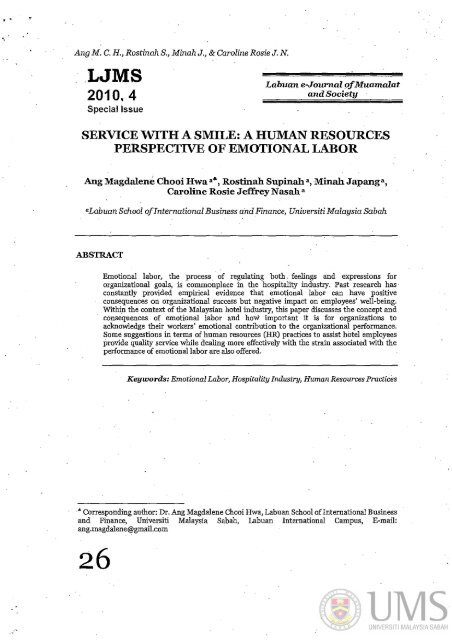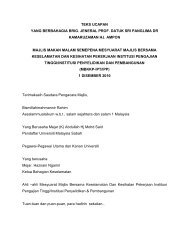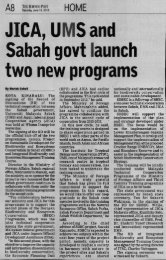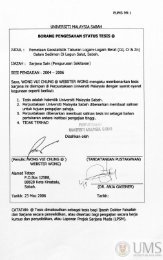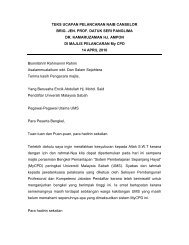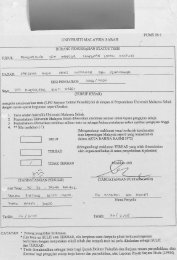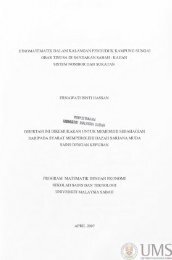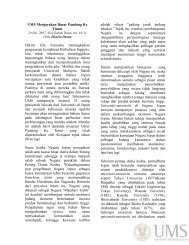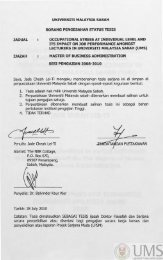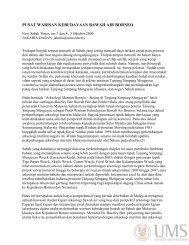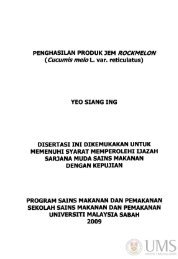service with a smile - UMS - Universiti Malaysia Sabah
service with a smile - UMS - Universiti Malaysia Sabah
service with a smile - UMS - Universiti Malaysia Sabah
You also want an ePaper? Increase the reach of your titles
YUMPU automatically turns print PDFs into web optimized ePapers that Google loves.
IO .' ,..<br />
'.<br />
Ang M. C. H., Rostinah S., Minah J., & Caroline Rosie J. N.<br />
WMS<br />
2010.4<br />
Special Issue<br />
Labuan e-Journal f:)fMuamalat<br />
and Society<br />
SERVICE WITH A SMILE: A HUMAN RESOURCES<br />
PERSPECTIVE OF EMOTIONAL LABOR<br />
Aug Magdalene Chooi Hwa a", Rostinah Supinah a,Minah Japanga,<br />
Caroline Rosie Jeffrey N asah a<br />
aLabuan School of International Business and Finance, <strong>Universiti</strong> <strong>Malaysia</strong> <strong>Sabah</strong><br />
ABSTRACT<br />
Emotional labor, the process of regulating both. feelings and expressions for<br />
organizational goals, is commonplace in the hospitality industry. Past research has'<br />
constantly provided empirical evidence that emotional labor can have positive<br />
consequences on organizational success but negative impact on employees' well-being.<br />
Within the context of the <strong>Malaysia</strong>n hotel industry, this paper discusses the concept and<br />
consequences of emotional labor and how important it is for organizations to<br />
acknowledge their workers' emotional contribution to the organizational performance.<br />
Some suggestions in terms of human resources (HR) practices to assist hotel employees<br />
provide quality <strong>service</strong> while dealing more effectively <strong>with</strong> the strain associated <strong>with</strong> the<br />
performance of emotional labor are also offered.<br />
Keywords: Emotional Labor, Hospitality Industry, Human Resources Practices<br />
• Corresponding author: Dr. Ang Magdalene Chooi Hwa, Labuan School of International Business<br />
and Finance, <strong>Universiti</strong> <strong>Malaysia</strong> <strong>Sabah</strong>, Labuan International Campus, E-mail:<br />
ang.magdalene@gmaiI.com<br />
26
.'<br />
Labuan e-Joumal ofMuamalat and Society, Vol. 4, 2010, pp. 26-33<br />
Introduction<br />
Identified as one of <strong>Malaysia</strong>'s key industries <strong>with</strong> great potential for growth, the tourism<br />
industry accounted for 7 per cent of <strong>Malaysia</strong>n economy in the year 2005 (Asia Times,'<br />
2005). This industry is entirely dependent on the hospitality industry which is a<br />
significant employer, <strong>with</strong> lodgingfhotels playing a critical role (Page & Connell, 2006).<br />
In 2004, the <strong>Malaysia</strong>n Hotel Association (MHA) <strong>Sabah</strong> Chapter was launched <strong>with</strong> the<br />
aim: to further improve the quality of <strong>service</strong>s in the hotel industry for <strong>Sabah</strong> and the<br />
Federal Territory of Labuan (Labuan). The greatest challenge confronting MHA <strong>Sabah</strong><br />
Chapter now is perhaps addressing the issue of losing quality manpower to other<br />
countries like Singapore, New Zealand, and Macau. The overseas. hotels and resorts are<br />
luring our skilled workforce in <strong>Sabah</strong> and Labuan to work for them by offering more<br />
lucrative salaries (Daily Express, October 4, 2008).<br />
We opine that to facilitate the development and improvement of the hotel industry in<br />
<strong>Malaysia</strong> as a whole, and notably in Labuan, injecting funding into the sector alone is not<br />
enough. Quality manpower that can provide world-class <strong>service</strong>s remains the key<br />
determinant of the industry's success and continued growth. As such funding efforts will<br />
go to waste if they are not accompanied by effective human resources (RR) practices in .<br />
terms of selection, training, and compensation of the hotel workforce. One area worthy<br />
of close attention is how hotel employees manage their emotions in the workplace and<br />
the outcomes of the process. The emphasis on emotion management is particularly<br />
pertinent given the fact that to remain courteous and friendly even.when having to deal<br />
<strong>with</strong> demanding and difficult customers is part and parcel of hotel employees' jobs.<br />
In light of the aforementioned, the objective of this paper is three-fold: (a) to provide·a<br />
better understanding of the concept of emotional labor and its consequences; (b) to bring<br />
greater awareness to the hotel industry of their employees' emotional contribution to the<br />
organizational performance; and (c) to suggest several HR practices that the hotel<br />
industry can employ to assist their workers in the management of emotional labor. The<br />
paper begins by clarifying the concept of emotional labor before it proceeds to discuss<br />
the impact of emotional labor on the organization and employees. Finally, <strong>with</strong>in the<br />
context of emotion management in the hotel industry, it discusses several HR practices<br />
in the areas of employee selection, training and development, and compensation.<br />
Emotional Labor·<br />
There is a generally held belief that there is no place for emotions in to day's rational,<br />
task-oriented work environments. Mann (1997) points out that emotions and their<br />
expression are, in. fact, controlled and managed in organizations by a wide range of<br />
formal and informal means (known as display rules), ensuring that certain emotions are<br />
expressed while others are suppressed. This is particularly true in <strong>service</strong> work setting in<br />
which employees are expected to conform to these expectations about emotional display<br />
even when they conflict <strong>with</strong> inner feeling. When this conflict results in individuals<br />
suppressing genuine emotion or expressing fake emotion, the work or effort involved in<br />
doing so is termed "emotionallabot".<br />
This term was coined in 1983 by Hochscl1ild to refer to the performance of various forms<br />
of work emotion in the context of paid employment. The current paper views emotional<br />
27
Ang M. ,c. H., Rostinah S., Minah J., & Caroline Rosie J. N.<br />
labor as "the process of regulating both feelings and expressions for organizational goals"<br />
(Grandey, 2000, p. 97) through the use of surface acting and deep acting.<br />
Over the years, emotion work has churned out various perspectives of emotional labor,<br />
ranging from two dimensions to multi-dimensions. For instance,. Hochschild (1983)<br />
describes two main techniques of managing one's emotions-surface acting and deep<br />
acting. Surfage acting relates to managing observable expressions, whereas deep acting<br />
corresponds to managing feelings. In other words, feelings are changed from the<br />
"outside in" in surface acting (faking feelings), whereas feelings are changed from the<br />
"inside out" in (active) deep acting (modifying inner feelings) (Kim, 2008). Hochschild<br />
(1983) also acknowledges another technique known as passive deep acting by which<br />
employees' feelings are spontaneously felt and displayed <strong>with</strong> no conscious effort. There<br />
is still an ongoing debate on whether the third technique should be included in the<br />
conceptualization of emotional labor since it lacks the process of internal dissonance and<br />
conscious effort (Mann, 1999). Kim (2008) contends that deep acting is synonymous<br />
<strong>with</strong> active deep acting (involving individuals' internal dissonance and effort) rather than<br />
passive deep acting. This suggests that emotional labor is best viewed as a twodimensional<br />
construct consisting of only surface acting and deep acting. In a Ilimilar<br />
vein, Grandey (2000) proposes that both processes of surface and deep acting<br />
correspond to the description of emotional labor as emotional regulation, To her, surface<br />
acting is emotional dissonance. On the other hand, d,eep acting is emotional regulation.<br />
AB noted earlier, this paper adopts Grandey"s (2000) view that these two dimensions of<br />
surface acting and deep acting alone can be used to operationalize emotional labor.<br />
The Consequences of Emotional Labor<br />
Previous work in the area of emotiOJiallabor consistently supports the notion proposed<br />
by Hochschild (1983) that emotional labor does and can have both functional and<br />
dysfunctional consequences for'the individual and the organization. Hochschild (1983)<br />
propounds that emotion management is detrimental to <strong>service</strong> employees because their<br />
emotions are now mandated by the organization. Conversely, the regulated emotional<br />
display is thought to benefit the organization. Kim (2008) similarly regards emotional<br />
labor to have double-edged effects: It can have positive influence on organizational<br />
success but negative impact on employees' well-being.<br />
With respect to the contribution of emotional labor to organizational success, there has<br />
been a growing connection of emotional labor to economic trends (Zeithaml,<br />
Parasuraman, & Berry, 1990) Specifically, it has been reported that emotional labor<br />
positively influences perception of <strong>service</strong> quality (Bowen, Siehl, & Schneider, 1989),<br />
customer loyalty, repeat business, financial gains (Heskett, Schlesinger, & Sasser, 1997),<br />
client satisfaction, and organizational productivity (Meier, Mastracci, & Wilson, 2006).<br />
Previous work has also documented that emotional labor negatively affects workers'<br />
well-being (Johnson & Spector, 2007), job satisfaction (Ang, Rostinall, Japang, & Nasall,<br />
2009; Jones, 1998; Yang & Chang, 2008), organizational commitment (Abrallam, 1999;<br />
Yang & Chang; 2008), and increases emotional exhaustion (Ang et al., 2009; Johnson &<br />
Spector, 2007; Kim, 2008), intent to leave (Abrallam, 1999), turnover (Meier et al.,<br />
2006), and work-family conflict (Seery, Corrigall, & Harpel, 2008). Generally, the<br />
influence of emotional labor on employee outcomes such as health, psychological well·<br />
being and work attitudes has generally been reported to be less favorable. However,<br />
some studies (e.g., Adelmann, 1995; ,Johnson, 2004; Wharton, 1993) have reported<br />
28
Labuan e-Journal of Muamalat and Society, Vol. 4, 2010, pp. 26-33<br />
otherwise. For instance, Wharton (1993) did not find a negative relationship but a<br />
positive relationship between emotional labor and job satisfaction. Wharton's (1993)<br />
argument is that the positive or negative outcome of emotional labor on employee<br />
outcomes depends on the performance technique which the employee chooses to use.<br />
What this means is that suppressing negative. emotions (Le., surface acting) is<br />
detrimental to employees' wellbeing (Gross, 1989; King & Emmons, 1990; Smith, 1992),<br />
whereas the expression of positive emotions (Le., to deep acting) may in turn enhance<br />
employees' well-being (Zajonc, 1985).<br />
Even though empirical findings of these relationships remain conflicting (Van Dijk &<br />
Kirk, 2006), the majority of past research has evidenced that deep acting leads to more<br />
favorable outcomes than does surface acting (Kim, 2008). Collectively, these findings<br />
hold important implications to the hotel industry in terms of HR practices. The next<br />
section discusses these practices in greater detail.<br />
Effective HUD1an Resource Practices: Some Recommendations<br />
The hotel. occupational norms, best typified. <strong>with</strong> the cliche "<strong>service</strong> <strong>with</strong> a <strong>smile</strong>",<br />
necessitate hospitality workers to perform emotional labor to achieve organizational<br />
goals. Even when having to deal <strong>with</strong> demanding and difficult customers, these<br />
employees are expected to remain courteous and friendly as part of satisfying customers<br />
and providing quality <strong>service</strong>. Yet, in doing so, they directly subject themselves to the<br />
negative consequences of emotional labor such as decreased job satisfaction, increased<br />
intention to quit, work-family conflict, and emotional exhaustion. Considering the<br />
detrimental effects· of emotional labor on employees' well-being and work outcomes;<br />
hotel employers need to reexanline their HR practices to deal <strong>with</strong> such situations. These<br />
HR practices will be discussed in three broad areas of selection, training and<br />
development,and compensation.<br />
Selection<br />
Selecting the right people for the job is crucial for employee performance simply because<br />
employees <strong>with</strong>. the right skills will do a better job for the company. Thus, hotel<br />
employers can make use of various selection tests arid techniques such as aptitude and<br />
personality tests. In context of the hotel industry, emotional intelligence test will be<br />
particularly relevant since it has been reported that effective management of workplace<br />
emotions, particularly using deep acting technique, requires high levels of EI (McShane<br />
& Von Glinow, 2010). This is because higher levels of EI indicate greater ability to<br />
regulate emotions in oneself and in others (McShane & Von Glinow, 2010).<br />
Personality tests are also useful for the selection of hotel employees as past studies have<br />
demonstrated that high positive affectivity people are capable of performing emotional<br />
labor in a genuine way (Chu, 2002). But when hotels want to hire high positive affectivity<br />
people for their ability to provide quality and sincere hospitality, the companies also.risk<br />
losing these people because of their propensity to experience emotional exhaustion more<br />
quickly (Chu,2002). Also, when jobs require high levels of emotional labor, training<br />
plays a more crucial role than selection. As such, it is perhaps more important for hotels<br />
to reconsider their employee .training and development programs that can help develop<br />
the necessary skills to perform emotional labor. This requires more concerted efforts by<br />
hotel employers to design effective training programs than relying on selection alone<br />
29
Ang M. C. H., Rostinah S., Minah J., & Caroline Rosie J. N.<br />
(Chu, 2002).<br />
Training and development<br />
Emotional labor training will assist employees when dealing <strong>with</strong> stressful guest<br />
transactions in a calmer .manner to achieve better quality <strong>service</strong>. Such training can be<br />
divided into 3 categories: (a) orientation program; (b) on-going training program; and<br />
(c) stress management program. In implementing these training programs, we propose<br />
the use of behavior modeling training, a training technique that has been reported to be<br />
"one of the most widely used, well researched, and highly regarded psychologically based<br />
training interventions" (Taylor, Russ-Eft, & Chan, 2005). Essentially, the procedure is<br />
comprised of modeling, role playing, social reinforcerrient, and transfer of training. To<br />
elaborate, employees are first shown good emotion management techniques, are asked to<br />
play employee-customer roles in simulated situation, and are then given feedback and<br />
praise by their supervisor or trainer (McShane & Von Glinow, 2010).<br />
Targeting at new recruits, orientation programs are used to convey appropriate attitudes<br />
and display rules. The focal point of such program is on customers' feelings-how to<br />
make them feel comfortable and welcomed. While it is still acceptable that the emphasis<br />
is on customers' and not employees' emotions at this stage, the hotel needs to be aware<br />
of the fact that eventually employees will be vulnerable to the negative consequences of<br />
emotional labor. Hence, training programs must also at some point focus on employees'<br />
feelings and well-being in order to provide the opportunity for employees to discuss their<br />
feelings and how to more effectively manage their emotions.<br />
This type of employee-focus training has several weighty benefits. First, it signals to the<br />
employees that the management is aware of and acknowledges the emotional<br />
contribution that they put into the jobs (Chu, 2002). By extension, employees'<br />
motivation and productivity on the job will be enhanced. Second, it provides the<br />
opportunity for employees to ventilate their negative emotions caused by their jobs. But<br />
more importantly, such training can develop in employees the ability to handle their<br />
anger and frustrations. To illustrate, we cite the words of a trainer for. such training<br />
program for flight attendants: "If a passenger snaps at you and you didn't do anything<br />
wrong, just remember it's not you he is snapping at. It's your uniform; it's your role as a<br />
Delta flight attendant. Don't take it personally" (Hochschild, 1983, p. 110).<br />
On-going training programs will be an extension of the orientation programs: However, .<br />
the emphasis would be to help employees how to perform deep acting-the emotional<br />
labor technique that has been consistently reported to result in more favorable outcomes<br />
for employees (e.g., increased job satisfaction and decreased emotional exhaustion) and .<br />
organizations alike (e.g., increased customer satisfaction and sincere hospitality).Chu<br />
(2002) propounds the importance of integrating deep acting into training to carefully<br />
regulate the internal processes of emotional management so that eXternal emotional<br />
expressions will appear to be more genuine and spontaneous. In addition, this type of<br />
training provides an excellent opportunity for employees to discuss their feelings and<br />
frustrations on their jobs, particularly when they are hurt or insulted by difficult guests.<br />
It should also be noted that such training should not be for front-line employees only but<br />
also for managers since the latter typically experience higher levels of emotional labor<br />
having to deal <strong>with</strong> both subordinates and customers (Chu; 2002). Both front-line<br />
employees and their managers can talk over negative emotions and exchange tips about<br />
expressing them in less offensive manners. Formal training programs for managers can<br />
30<br />
, .
· .<br />
Labuan e-Journal ofMuamalat and Society, Vol. 4; 2010, pp. 26-33<br />
incorporate modules such as "how to provide emotional support," "how to handle<br />
, employee complaints," and "how to provide constructive feedback and opinions" (Chu,<br />
2002).<br />
Past studies (e.g., Ang et al., 2009; Johnson, 2004) have found gender to influence the<br />
choice of acting method such that females tended to employ more deep ,acting when<br />
compared to their male counterparts. Hence, training and education in emotion<br />
management should also be gender-specific. Men may need more training in this aspect<br />
(Grandey, 2000).<br />
Performing emotional labor is stressful, particularly <strong>with</strong> the use of surface acting.<br />
Research (e.g., Allg et al., 2009; Johnson & Spector, 2007; Kim, 2008) has in fact<br />
reported that emotional labor can result in emotional exhaustion. Emotional exhaustion<br />
is a stress outcome that occurs when an employee is in the state of depleted energy<br />
(Jackson, Schwab, & Schuler, 1986). Hence, the final type of program should be aimed at<br />
helping hotel employees deal <strong>with</strong> the strain associated <strong>with</strong> emotional labor more<br />
effectively. Stress management programs should adopt emotion-focilsed coping rather<br />
than the problem-focused coping approach to deal <strong>with</strong> stressors. The former approach<br />
is the steps taken by an employee to address and alleviate stressful feelings and<br />
emotions, whereas the latter refers to the actions taken, directly <strong>with</strong> the source of stress<br />
(Ivancevich, Konopaske, & Matteson, 2008). The benefits of emotion-focused strategies<br />
include meditation, biofeedback, exercise, joining a work support group, and personal off<br />
days (Ivancevich et al., 2008} ,<br />
Compensation<br />
As noted earlier, emotional labor is important in influencing customer satisfaction and is<br />
equally significant in affecting the bottolllline. Lamentably, employees' emotional<br />
contribution has not been accordingly acknowledged by the management. Whereas<br />
mental and physical labor gets compensated fairly well, emotional labor performers in<br />
the hotel industry seem to receive relatively lower wages (Chu, 2002). Hence,<br />
establishing. strategic pay plans is a very crucial-management agenda. The central point<br />
is that when hotel employees successfully deep act to provide quality and genuine<br />
<strong>service</strong>, they need to be not only recognized but also rewarded for their efforts.<br />
That being said, if hotel employers in Labuan and <strong>Sabah</strong> can start redesigning their pay<br />
structures to properly recognize the emotional contribution made by their workers,<br />
perhaps the issue of losing skilled and experienced workers to other countries that<br />
promise more attractive wages can be dealt <strong>with</strong> more aptly. Additionally, competitive<br />
compensation structure can pose as an effective means to attract more quality candidates<br />
to the <strong>Malaysia</strong>n hotel industry.<br />
Conclusion<br />
The role and importance of emotional labor in the hotel industry setting has been<br />
elucidated in this paper. The paper has also argued that effectiveHR practices.have to be<br />
in place should <strong>Malaysia</strong>n hotels want to attract as well as retain high quality workforce.<br />
In essence, the management needs to create conditions for satisfying work and less<br />
stressfulwork environment for employees. , Equally necessary is for managers to regulate<br />
or monitor employees' behavior or emotional expressions to ensure <strong>service</strong> quality. The<br />
31<br />
J •
..<br />
Ang M. C. H., Rostinah S., Minah J., & Caroline Rosie J. N.<br />
use of formal or informal means to ventilate employees' anger and frustrations on the job<br />
is also of utmost importance. If not, sooner or later, the employees will start to express<br />
their anger to the customers or subsequently leave the jobs. On a final note, the<br />
responsibility of implementing effective HR practices lies <strong>with</strong> every manager-not just<br />
those in human resources (Dessler, 2008).<br />
References<br />
Abraham, R. (1999). The impact of emotional dissonance on organizational commitment<br />
and intention to turnover. Journal of Psychology, 133, 441-455.<br />
Adelmann, P. K. (1995). Emotional labor as a potential source of job stress. In S. L.<br />
. Sauter & L. R. Murphy (Eds.), Organizational. risk factors for job stress (pp. 371-<br />
381). Washington, DC: American Psychological Association .<br />
. Ang, M.C.H., Rostinah, S., Japang, M.C., & Nasah, C.R.J. (2009). Emotional labor,<br />
employee outcomes, support, and job autonomy: An empirical investigation of<br />
hotel workers in <strong>Sabah</strong> and F.T. Labuan. <strong>UMS</strong>-Seed Money Research Grant.<br />
Asia Times (January 4, 2005). <strong>Malaysia</strong> escapes, but not unscathed. Retrieved<br />
September lO,· 2009, from<br />
http://wviw.atimes.com/atimes/SoutheasCAsia/GAo4Ae05.html.<br />
Bowen, D. E., Siehl, C., & Schneider, B. (1989). A framework for analyzing customer<br />
<strong>service</strong> orientations in manufacturing. Academy of Management Review, 14, 75-<br />
95·<br />
Chu, K. H. (2002). The effects of emotional labor on employee work outcomes.<br />
Unpublished doctoral. dissertation, the Faculty of the Virginia Polytechnic<br />
Institute and State University. Blacksburg, Virginia.<br />
Daily Express (October 4, 2008). <strong>Sabah</strong> hospitality sector losing skilled workers.<br />
Retrieved September lO, 2009 from<br />
http://www.dailyexpress.com.my/news.cfniNewsID=60202.<br />
Dessler, G. (2004). Human resource management (llth ed.). Upper Saddle River, NJ:<br />
Pearson Prentice Hall.<br />
Grandey, A A (2000). Emotion regulation in the workplace: A new way to conceptualize<br />
emotional labor. Journal of OcCupational Health Psychology, 5, 95-ll0.<br />
Gross, J. (1989). Emotion expression in. cancer onset and progression. Social Science·<br />
and Medicine, 28, 1239-1248.<br />
Heskett, J. L., Schlesinger, L.A, Sasser, W. E. (1997). The <strong>service</strong> profit chain: How<br />
leading companies link profit and growth to loyalty, satisfaction and value.<br />
New York: The Free Press.<br />
Hochschild, A R (1983). The managed heart: Commersialization of human feeling.<br />
Berkeley, CA: University of California Press.<br />
Ivancevich, J.M., Konopaske, R., & Matteson, M.T. (2008). Organizational behavior<br />
·and management (8th ed.). New York: McGraw-Hill Irwin.<br />
JaCkson, S. E., Schwab, R L., &: Schuler, R S. (1986).Toward an understanding of the<br />
burnout phenomenon. Journal of Applied Psychology, 71, 630-640.<br />
Johnson, H. A (2004). The story behind <strong>service</strong> <strong>with</strong> a <strong>smile</strong>: The effects of emotional<br />
labor on job satisfaction, emotional exhaustion, and affective well-being.<br />
Unpublished Master of Arts thesis, Department of Psychology, University of<br />
South Florida, U.S. .<br />
Johnson, H. A, & Spector, P. E. (2007). Service <strong>with</strong> a <strong>smile</strong>: Do emotional intelligence,<br />
gender, and autonomy moderate the emotional labor process Journal of<br />
Occupational Health Psychology, 12, 319-333.<br />
32
..,<br />
"<br />
Labuan e-Journal ofMuamalat and Society, Vol. 4, 2010, pp. 26-33<br />
Jones, J. R. (1998). An examination of the emotional labor construct and its effeCts on<br />
employee outcomes. ETD collection for University of Nebraska, University of<br />
Nebraska, U.S.<br />
Kim, H. J. (2008). Hotel <strong>service</strong> providers' emotional labor: The antecedents and effects<br />
on burnout. International Journal of Hospitality Management, 27, 151-161.<br />
King, L.A, & Emmons, R. A. (1990). Conflict over emotional expression: Psychological<br />
and physical corrleates. Journal of Personality and Social Psychology,. 58, 864-<br />
8n<br />
Mann, S. (1997). Emotional labor in organizations. Leadership and Organization<br />
Development Journal, 18, 4-12. .<br />
McShane, S. 1., & Von Glinow, M. A. (2010). Organizational behavior: Emerging<br />
knowledge and practice for the real world (5 th ed.). Boston: MCGraw-Hill-Irwin.<br />
Meier, K. J., Mastracci, S. H., & Wilson, K. (2006). Gender and emotional labor in public<br />
organizations: An empirical examination of the link to performance. Public<br />
AdministrationReview, 66, 899-909.<br />
Page, S., & Connell, J. (2006). Tourism: A Modern Synthesis. Toronto: Thomson.<br />
Seery, B. 1., Corrigall, E. A., & Harpel, T. (2008). Job-related emotional labor and its<br />
relationship to work-family conflict and facilitation. Journal of Family and<br />
Economic Issues, 29,,461-477.<br />
Smith, T. W. (1992). Hostility and health: Current status of a psychosomatic hypotheSIs.<br />
Health Psychology, 11, 130-150.<br />
Taylor, P.J., Russ-Eft, D.F., & Chan, D.W.L. (2005). A meta-analytic review of behavior<br />
modeling training. Journal of Applied Psychology, 90, 4, 692-719.<br />
Van Dijk, P. & Kirk, A. (2006). Emotional labor and negative job outcomes: An<br />
evaluation of the mediating role of emotional dissonance. Journal of<br />
Management and Organization, 12, 101-115. .<br />
Wharton, A. S. (1993). The affective consequences of <strong>service</strong> work. Work and<br />
Occupations, 20, 205-232.<br />
Yang, F.H., & Chang, C. C. (2008). Emotional labor, job satisfaction, and organizational<br />
commitment amongst clinical nurses: A questionnaire survey. International<br />
Journal of Nursing Studies, 45, 879-887.<br />
Zajonc, R. B. (1985). Emotion and facial efference: An ignored theory reclaimed. Science,<br />
228,15-21.<br />
Zeithaml, V. A., Parasuraman, A., & Berry, 1. 1. (1990). Delivering quality <strong>service</strong>:<br />
. Balancing customer perceptions and expectations. New York: Free Press.<br />
33


